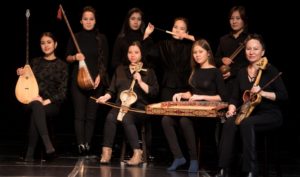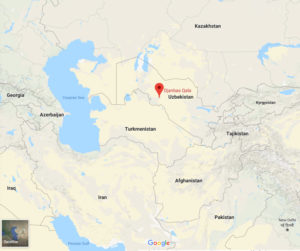 An intriguing and unpronounceable name: it actually sounds more like clicks when said by a native speaker. Before the show, there was an introduction with the director, Saodat Ismailova, talking with Ted Levin. He is involved with the Aga Khan Music Initiative, which is intended to fund music projects in developing areas like Uzbekistan. The Aga Khan is actually a person, and head of a branch of Islam. The articulate and lovely Saodat had an interesting Q&A session with Ted, talking about how the project developed. We learned that the “40 girls” story is like our equivalent of a fairy tale: everyone in the region knows about it. Around the 4th to 6th century BC, a princess led 40 girls to defend her land.
An intriguing and unpronounceable name: it actually sounds more like clicks when said by a native speaker. Before the show, there was an introduction with the director, Saodat Ismailova, talking with Ted Levin. He is involved with the Aga Khan Music Initiative, which is intended to fund music projects in developing areas like Uzbekistan. The Aga Khan is actually a person, and head of a branch of Islam. The articulate and lovely Saodat had an interesting Q&A session with Ted, talking about how the project developed. We learned that the “40 girls” story is like our equivalent of a fairy tale: everyone in the region knows about it. Around the 4th to 6th century BC, a princess led 40 girls to defend her land.
The story has been transmitted by oral tradition (like the Iliad), but the last bard who had been told the story died in 2004. Saodat ended up researching archival recordings of that bard. She felt that a 300-page story that lasted all night would be too long, so she wanted to tell the story for modern audiences. Although a filmmaker, when she met with Ted, they decided to collaborate on a film with live music.
Ted is obviously very familiar with the region, and seemed to be able to speak to her in some language that I couldn’t hear (but not English). He had organized the Hun Huur Tu (throat singers of Tuva) concert in 2004 (?), from the same neck of the world
 The concert proper was in Moore theater, and was well attended. Overhead, the movie was beautiful, with stark images from the Uzbekistan/Turkmenistan region. Ancient ruins, desert cliffs, and a young woman who played the princess Gulayim.
The concert proper was in Moore theater, and was well attended. Overhead, the movie was beautiful, with stark images from the Uzbekistan/Turkmenistan region. Ancient ruins, desert cliffs, and a young woman who played the princess Gulayim.
On stage, a group of young women sang plaintive songs accompanied by twangy guitar-like instruments or the eerie stringed ghirjek. The stage was dim, and the women entered and exited with slow and stately movements. The overall effect was strikingly beautiful. The music was composed by Dimitri Yanov-Yanovsky, based in Tashkent. The lyrics for the songs were traditional, along with the instruments. Languages included Kazakh, Uzbek, Karakalpak, ….
The movie followed the story via four elements earth, air, water and fire. Not really related to the story, but part of Zoroastrianism, which takes its roots in the region. Judging by the Q&A after the show, I think the audience didn’t see how all this tied in. One question was about the battle: should there have been one in the movie? The director explained that she wanted to get the feeling of a 16-year old girl, who hadn’t had children. How would she feel about war? Everything would be intense, and she would go all out. She chose to portray this as dancing in a disco. Lost on us I guess.
At the end of the film, the musicians then recited names, 40 of course. We learned afterwards that it was a who’s who of famous women from the region, including the director of course.
The percussionist and conductor Alibek Kabdurakhmanov, one performer, Saodat and Ted came out after for a Q&A. All spoke English quite well, which was a suprise. The conductor said it was a miracle to get all the girls performing together. Even though they were from the same general region, they were from all different countries, and communication was difficult.
